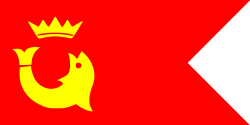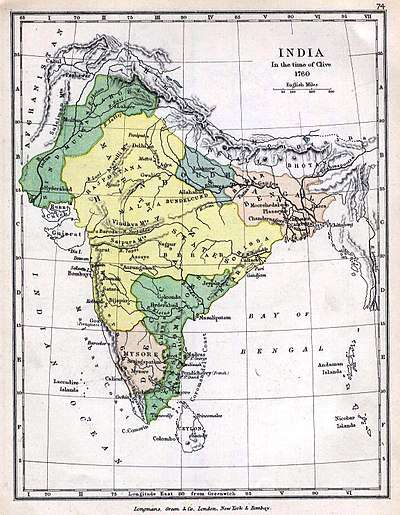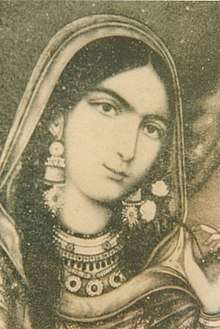Oudh State
| State of Oudh (1801-1858) Kingdom of Oudh (1732-1801) | |||||||||||
|---|---|---|---|---|---|---|---|---|---|---|---|
| 1732–1859 | |||||||||||
 Flag
 Coat of arms
| |||||||||||
 The Kingdom of Oudh in 1760 (Sapphire blue) | |||||||||||
| Status |
Independent/Mughal Successor State (1732–1801) Vassal of the East India Company (1801–1858) | ||||||||||
| Capital |
Faizabad Lucknow | ||||||||||
| Common languages | Urdu | ||||||||||
| Religion | Islam | ||||||||||
| Government |
Independent/Mughal Successor State (1732–1816) Princely State (1816–1858) | ||||||||||
| Nawab | |||||||||||
• 1722–1739 | Saadat Ali Khan I (first) | ||||||||||
• 1856 | Wajid Ali Shah (last) | ||||||||||
| History | |||||||||||
• Established | 1732 | ||||||||||
| 5 – 25 June 1858 | |||||||||||
| 3 Mar 1859 | |||||||||||
| Area | |||||||||||
| 62,072 km2 (23,966 sq mi) | |||||||||||
| Currency | rupee | ||||||||||
| |||||||||||



The Oudh State (/ˈaʊd/[1], also Kingdom of Oudh, or Awadh State) was a princely state in the Awadh region of North India until 1858. Oudh, the now obsolete but once official English-language name of the state, also written historically as Oude, derived from the name of Ayodhya.
The capital of Oudh State was in Faizabad, but the British Agents, officially known as "residents", had their seat in Lucknow. The Nawab of Oudh, one of the richest princes, paid for and erected a Residency in Lucknow as a part of a wider programme of civic improvements.[2]
Oudh joined other Indian states in an upheaval against British rule in 1858 during one of the last series of actions in the Indian rebellion of 1857. In the course of this uprising detachments of the British Indian Army from the Bombay Presidency overcame the disunited collection of Indian states in a single rapid campaign. Determined rebels continued to wage sporadic guerrilla clashes until the spring of 1859. This rebellion is also historically known as the Oudh campaign.[3]
After the British annexation of Oudh by the Doctrine of Lapse, the North Western Provinces became the North Western Provinces and Oudh.[4]
History
Establishment of the State of Oudh
In 1732, under nominal Mughal sovereignty, a senior official of the Mughal Empire, Saadat Khan, established a hereditary polity in Oudh, later enhancing his position by cooperating with Nader Shah during his invasion of India. As regional officials asserted their autonomy in Bengal and the Deccan as well as with the rise of the Maratha Empire, the rulers of Oudh gradually affirmed their own sovereignty. Safdar Jang went as far as to control the ruler of Delhi, putting Ahmad Shah Bahadur on the Mughal throne with the cooperation of other Mughal nobility.[5]:132
Since Oudh was located in a prosperous region, the British East India Company soon took notice of the affluence in which the Nawabs of Oudh lived. British dominance was established at the Battle of Buxar of 1764, when the East India Company defeated the alliance between the nawab of Oudh Shuja-ud-Daula and the deposed nawab of Bengal Mir Kasim.[6]:25 The result would be direct British interference in the internal state matters of Oudh, useful as a buffer state. Hastings even aided Oudh militarily against the rebelling Rohilla.[6]:65
The kingdom became a British protectorate in May 1816 (However, the state was an unofficial British protectorate since 1764). Three years later, in 1819, the ruler of Oudh took the style of padshah (king), signaling formal independence under the advice of the Marquis of Hastings.
Throughout the early 1800s until annexation, several areas were gradually ceded to the British.
British annexation
On 7 February 1856 by order of Lord Dalhousie, General of the East India Company, the king of Oudh (Wajid Ali Shah)was deposed,and its kingdom was annexed to British India under the terms of the Doctrine of lapse on the grounds of alleged internal misrule.[7]
Between 5 July 1857 and 3 March 1858 there was an upheaval by the son of the deposed king joining the Indian Rebellion of 1857. At the time of the rebellion, the British lost control of the territory; they reestablished their rule over the next eighteen months, during which time there were massacres such as those that had occurred in the course of the Siege of Cawnpore.[8][9]
After Oudh's territory was merged with the North Western Provinces, it formed the larger province of North Western Provinces and Oudh. In 1902, the latter province was renamed the United Provinces of Agra and Oudh, and in 1904 the region within the new United Provinces, corresponding to the former North Western Provinces and Oudh, was renamed the Agra Province.[7]
Government
Feudatory states
The following were feudatory estates —taluqdaris[10] or parganas— of Oudh:
- Balrampur Estate[11]
- Benares State until 1775
- Bhadri Estate[12]
- Itaunja Estate[13]
- Nanpara Taluqdari[14]
- Pratapgarh Estate
- Tulsipur State
Rulers
The first ruler of Oudh State belonged to the Shia Muslim Sayyid Family and descended of Musa al-Kadhim originated from Nishapur. But the dynasty also belonged from the paternal line to the Kara Koyunlu through Qara Yusuf. They were renowned for their secularism and broad outlook.[15]
All rulers used the title of 'Nawab'.[16]
Subadar Nawabs
- 1732 – 19 Mar 1739 Borhan al-Molk Mir Mohammad Amin (b. c.1680 – d. 1739) Musawi Sa`adat `Ali Khan I
- 19 Mar 1739 – 28 Apr 1748 Abu´l Mansur Mohammad Moqim Khan (1st time) (b. c.1708 – d. 1754)
Nawab Wazir al-Mamalik
- 28 Apr 1748 – 13 May 1753 Abu´l Mansur Mohammad Moqim Khan (s.a.) (acting to 29 Jun 1748)
Subadar Nawab
- 5 Nov 1753 – 5 Oct 1754 Abu´l Mansur Mohammad Moqim Khan (s.a.) (2nd time)
- 5 Oct 1754 – 15 Feb 1762 Jalal ad-Din Shoja` ad-Dowla (b. 1732 – d. 1775) Haydar
Nawab Wazir al-Mamalik
- 15 Feb 1762 – 26 Jan 1775 Jalal ad-Din Shoja` ad-Dowla (s.a.) Haydar
- 26 Jan 1775 – 21 Sep 1797 Asaf ad-Dowla Amani (b. 1748 – d. 1797)
- 21 Sep 1797 – 21 Jan 1798 Mirza Wazir `Ali Khan (b. 1780 – d. 1817)
- 21 Jan 1798 – 11 Jul 1814 Yamin ad-Dowla Nazem al-Molk (b. bf.1752 – d. 1814) Sa`adat `Ali Khan II Bahadur
- 11 Jul 1814 – 19 Oct 1818 Ghazi ad-Din Rafa`at ad-Dowla (b. 1769 – d. 1827) Abu´l-Mozaffar Haydar Khan
Kings (Padshah-e Awadh, Shah-e Zaman)
- 19 Oct 1818 – 19 Oct 1827 Ghazi ad-Din Mo`izz ad-Din (s.a.) Abu´l-Mozaffar Haydar Shah
- 19 Oct 1827 – 7 Jul 1837 Naser ad-Din Haydar Solayman (b. 1803 – d. 1837) Jah Shah
- 7 Jul 1837 – 17 May 1842 Mo`in ad-Din Abu´l-Fath Mohammad (b. 1777 – d. 1842) `Ali Shah
- 17 May 1842 – 13 Feb 1847 Naser ad-Dowla Amjad `Ali Thorayya (b. 1801 – d. 1847) Jah Shah
- 13 Feb 1847 – 7 Feb 1856 Naser ad-Din `Abd al-Mansur (b. 1822 – d. 1887) Mohammad Wajed `Ali Shah
- 5 Jul 1857 – 3 Mar 1858 Berjis Qadr (in rebellion) (b. 1845? – d. 1893)
Residents
- Nathaniel Middleton 1773 – 1774
- John Bristow 1774 – 1776
- Nathaniel Middleton 1776–1779 (second time)
- Purling 1779 – 1780
- John Bristow 1780 – 1781 (second time)
- Nathaniel Middleton 1781 – 1782 (third time)
- John Bristow 1782–1783 (third time)
- Edward Otto Ives 1784 – 1793
- George Frederick Cherry 1793 – 1796
- James Lumsden 1796 – 1799
- William Scott 1799 – 1804
- John Ulrich Collins 1804 – 1807
- John Baillie 1807 – 1815
- Richard Charles Strachey 1815 – 1817
- J.R. Monckton 1818 – 1820
- Felix Vincent Raper 1820 – 1823
- Mordaunt Ricketts 1823 – 1827
- Thomas Herbert Maddock 1829 – 1831
- John Low 1831 – 1842
- James Caulfield (interí) 1839 – 1841
- William Nott 1841–1843
- George Pollock 1843 – 1844
- Archibald Richmond 1844 – 1849?
- Sir William Henry Sleeman 1849 – 1854
- Sir James Outram 1854 – 1856
Demographics
In the early eighteenth century, the population of Oudh was estimated to be 3 million. Oudh underwent a demographic shift in which Lucknow and Varanasi expanded to become metropolises of over 200,000 people over the course of the 18th century at the expense of Agra and Delhi. During this period the land on the banks of the Yamuna suffered frequent dry spells, while the Baiswara did not.[17]:38
Although it was ruled by Muslims, a majority, roughly four fifths, of Oudh's population were Hindus.[5]:155[18]
Culture
Religion
The cities of Allahabad, Varanasi, and Ayodhya were important pilgrimage sites for followers of Hinduism and other Dharmic religions. The town of Bahraich was also revered by some Muslims.[19]
See also
References
- ↑ Oudh – definition of Oudh in English from the Oxford dictionary
- ↑ Davies, Philip, Splendours of the Raj: British Architecture in India, 1660–1947. New York: Penguin Books, 1987
- ↑ Michael Edwardes, Battles of the Indian Mutiny, Pan, 1963, ISBN 0-330-02524-4
- ↑ Ashutosh Joshi (1 Jan 2008). Town Planning Regeneration of Cities. New India Publishing. p. 237. ISBN 8189422820.
- 1 2 Jaswant Lal, Mehta (2005). Advanced Study in the History of Modern India: 1707-1813. Sterling Publishers. ISBN 9781932705546.
- 1 2 Ramusack, Barbara N. (2004). The Indian Princes and their States. Cambridge University Press.
- 1 2 Imperial Gazetteer of India vol. V 1908, p. 72
- ↑ Ben Cahoon. "Princely States of India – Oudh". Worldstatesmen.org. Retrieved 2014-08-08.
- ↑ William Barton, The princes of India. Delhi 1983
- ↑ The Feudatory and zemindari India, Volume 17, Issue 2. 1937. Retrieved 4 August 2014.
- ↑ Balrampur (Taluqdari)
- ↑ Bhadri (Taluq)
- ↑ Itaunja – Raipur Ekdaria (Taluq)
- ↑ The Indian Year Book, Volume 29. Bennett, Coleman & Company. 1942. p. 1286. Retrieved 6 August 2014.
- ↑ Dr. B. S. Saxena (1974). "Repertoire On Wajid Ali Shah & Monuments of Avadh – Nawabs of Oudh & their Secularism". Avadh Cultural Club (Lucknow).
- ↑ Ben Cahoon. "List of rulers of Oudh". Worldstatesmen.org. Retrieved 2014-08-08.
- ↑ Cole, J. R. I. (1989). Roots of North Indian Shīʾism in Iran and Iraq: Religion and State in Awadh, 1722-1859. Comparative Studies on Muslim Societies. University of California Press. ISBN 9780520056411.
- ↑ Defence Journal, Volume 5, Issues 2-4. p. 88.
On the contrary the annexation of Oudh in 1856 was viewed by the Muslim elite and the Hindu majority population of Oudh
- ↑ Surya Narain Singh (2003). The Kingdom of Awadh. Mittal Publications.
External links

- Heraldry of Oudh State
